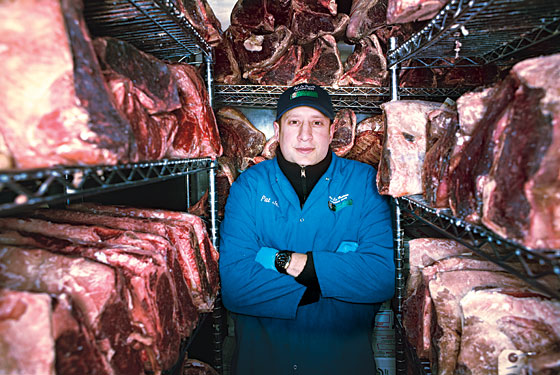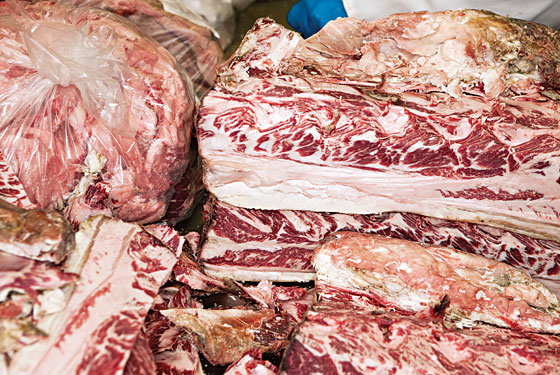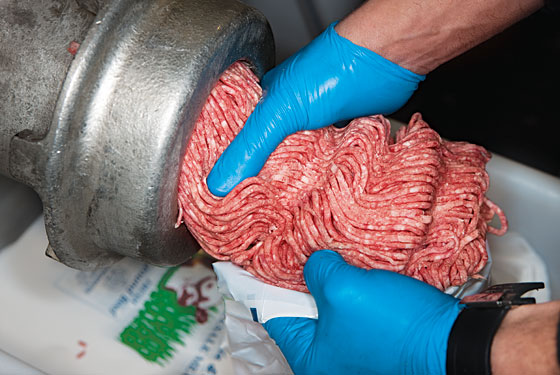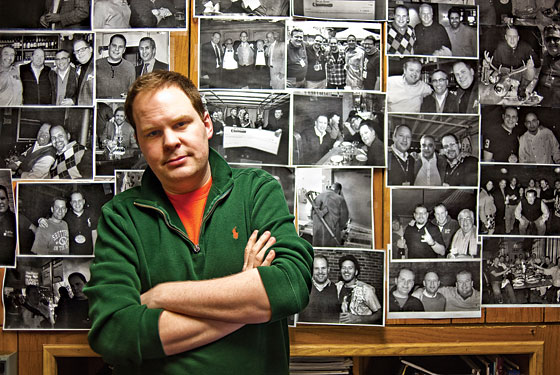
Early one morning, not long ago, Pat LaFrieda decided to conduct an experiment. A tall, square-jawed 38-year-old who could pass for an Army commander—he spent eight years in the reserves—Pat runs Pat LaFrieda Wholesale Meat Purveyors, a meat supplier in the West Village that was co-founded by his grandfather (a.k.a. “the original Pat LaFrieda”) in 1922. Pat’s workday is relentless, beginning at nine in the evening and ending at seven the following morning, most of it spent chugging anything caffeinated while cutting meat in what is essentially a gigantic freezer; afterward, he’ll often grab something to take home—a marbled cut of prime Black Angus hanger, say, or a juicy short-rib pinwheel—to cook for his wife and young son. On this occasion, however, he opted to do something different. Hooking himself a piece of dry-aged rib eye, one of the wholesaler’s most expensive cuts, he tossed it into the meat grinder. A believer that few flavors can compete with the funky intensity of a perfectly dry-aged steak, Pat was simply curious: What, exactly, would it taste like in a hamburger?
Around the same time, Pat’s cousin and partner in the business, Mark Pastore, was nursing a burger-related idea of his own. Whereas Pat is the born butcher of the two, with the scars cross-hatching his hands to prove it, Mark is the intrinsic marketer, a gregarious 35-year-old who dabbled in nightlife PR before entering the world of wholesale meats. A tireless networker who often visits three different restaurants in a night, Mark is happiest when sipping a Campari and grapefruit juice (“It’s true, I’m the gay meat guy”) while eating his own product prepared by a member of his “family”—i.e., one of the many famed chefs that feature Pat LaFrieda meats on their menus. What Mark wanted to know was whether Pat LaFrieda could create the world’s most expensive hamburger meat. Restaurants typically pay around $2.25 a pound for ground beef; Mark was keen to fashion something bordering on ridiculous, something that would go for as much as $11.99 a pound. And so on a Friday morning, when he and Pat caught up during the shift change, Mark broached the topic while the two were crammed inside the tiny wood-paneled office they share in the corner of the wholesaler’s facility.
Mark: “Think it’s even possible?”
Pat: “Funny you ask. I’ve been playing around with dried beef and— ”
Mark: “Ooooohhh! I love it!”
There was a time when the idea of turning a piece of dry-aged beef into a burger would be considered an act of blasphemy, not unlike shredding a Chanel gown to make a bandanna. But as any wanton carnivore can attest, and as Pat and Mark understand better than most, New York has become a town smitten with reinventing the hamburger. Ever since Danny Meyer (Union Square Cafe, Gramercy Tavern) opened Shake Shack in Madison Square Park and proved that the epicurious would stand in line for an hour to devour a highbrow spin on a lowbrow favorite, it seems hardly a month passes without a well-known restaurateur introducing his own version of the gourmet burger. Stephen Hanson did it with Bill’s Bar & Burger, and outposts like 5 Napkin Burger, BLT Burger, and Stand have spawned cult followings, while the creations introduced by chefs like April Bloomfield (the Spotted Pig) and Joey Campanaro (the Little Owl) are deconstructed and praised in a way once reserved for the delicate wizardry of masters like Jean-Georges. Culinary scholars may point to any number of factors for this trend, ranging from the obvious (burgers are delicious) to the socioeconomic (even expensive burgers are recession-friendly) to the cross-cultural obliteration of the high-low divide (burgers are pretentiously unpretentious). There may, however, be a simpler explanation: Every restaurant mentioned above, not to mention dozens of other contenders in the perennial best-burger debate, gets its meat from the men of Pat LaFrieda.
And so it was perhaps inevitable, given Pat and Mark’s reputation as burger gurus within New York’s restaurant community, that what began as what Mark calls a “mad-scientist moment” with dry-aged meat was bound to become a sensation. Indeed, once Pat perfected the blend, and once Mark, after driving past a Johnnie Walker billboard, had christened it with the seductive name “Black Label,” the phones began ringing with chefs and restaurateurs eager for a taste. Among those interested were Riad Nasr and Lee Hanson, the co-chefs at Keith McNally’s Minetta Tavern in the West Village, which was in the process of being converted into the VIP clubhouse it has since become. A few days after Mark sent over a sample, Nasr and Hanson called back with a request that Pat and Mark had grown used to hearing when it came to their varieties of ground-beef meat: Not only did they want the meat, but they also wanted Minetta to be the only restaurant in New York that served it. The final result: the $26 Black Label burger, which presently stands as the reigning haute burger in town, lusted after by critics and fetishized on food blogs—further evidence that, as much as any chef or restaurateur, Pat and Mark are the team quietly responsible for stoking a burger boom that shows no signs of abating.

Originally located in the meatpacking district, and then for many years on Bleecker Street, Pat LaFrieda Wholesale Meat Purveyors is today housed in a series of low-slung buildings running the entire block of Leroy Street between Washington and Greenwich Streets. It is a 24-hour operation, Monday through Friday, with all of the cutting done at night, once restaurants have closed and had time to survey what they need for the next day’s service. Pat’s father, Pat LaFrieda II, who at age 63 still drives in daily from Bensonhurst at 3:30 in the morning to check up on things, bought up the property 35 years ago, which makes for a low overhead, allowing the company to keep prices relatively reasonable for high-grade, fastidiously sourced meat.
But as the evolution of the Black Label burger best illustrates, what separates Pat and Mark from their competitors is their innate understanding of the fickle and competitive nature of New York chefs, who more than anything want to be able to offer customers something they can’t find anywhere else. To accommodate this, the pair devised an innovation, working with restaurants to come up with a customized “blend”—typically a variation of percentages of brisket, chuck, short rib, and skirt steak—that will be sold to one restaurant exclusively. And so while the burgers at Shake Shack and the Spotted Pig are created in the same machines and delivered by the same vans, the precise components, which are kept secret thanks to thick confidentiality agreements, are wholly unique, customized for each chef’s taste and cooking surfaces.
“It used to be that if you wanted to stand out from the guy across the street, you had to find a different supplier,” Pat explained to me, while taking a break during a recent shift. “What we do, basically, is become a different supplier for every restaurant.” It was nearing two in the morning. Hosea Rosenberg, the winner of the fifth season of Top Chef, had just stopped by to observe the operation. “I think he might be opening a place in New York. People like that come by all the time,” Pat noted proudly, draining his second Red Bull of the night before continuing with the burger discussion. “The whole thing started with Danny Meyer and the Shake Shack. Danny came to us and said he was opening a kind of burger shack and wanted something unique. Danny’s a genius at what he does, obviously, but we thought the idea was pretty crazy. Then Shake Shack opened and the lines were ridiculous. People were waiting over an hour, and suddenly our phones were going crazy.” Pat checked some orders—Dovetail needed more beef cheeks, Marea was short on bone marrow—and went on. “Every restaurant in town was calling us and saying, ‘Can we have the Shake Shack blend?’ ” Pat said. “I’m like, ‘No way, sorry, that’s Danny Meyer’s. I’m not even allowed to talk about what’s in it exactly. But tell me what you’re thinking, and we’ll come up with something special for you.’ ”
While this kind of attitude is good for Pat’s business—what client doesn’t prize die-hard loyalty?—it’s also a boon for burger fetishists, ensuring that no two creations at the city’s premier hamburger palaces taste the same. For those who don’t understand the system, Pat has little patience. After Frank Bruni declared Minetta the best steakhouse in the city, for instance, Peter Luger, the famous Brooklyn steakhouse, contacted Pat LaFrieda about supplying it with meat. “Never, never, never will I cut meat for Peter Luger,” Pat declared. “They have no loyalty. They’re rainy-day customers. They buy from many meat companies. We don’t work that way.” (A Luger buyer says the restaurant uses multiple suppliers in order to serve its customers “the best of the best.” She says the restaurant has used many of the same suppliers for decades.) Similarly, a few days before I met him, Pat had received a call from Old Homestead Steakhouse, the historic restaurant on Ninth Avenue, asking to sample ten pounds of the custom blends used by Bill’s Bar & Burger and Minetta Tavern. Pat was polite when he took the call—“Yeah, sure thing, I’ll send it over”—before tossing the order in the trash the moment he hung up. “We’ve never really done any business with them,” Pat told me. The issue, as he saw it, was an unapologetic lack of original thinking. “Here’s a restaurant that’s been around since the 1800s, right?” Pat said. “And now they’re gonna ask me for two of my proprietary blends.” He shook his head. “Impossible. Never gonna do it.” When Old Homestead called back a few days later, Pat offered to make it a custom blend of its own; Old Homestead happily agreed.

Composing the perfect blend involves a complex back-and-forth between Pat LaFrieda and a restaurant that can take a few months. To come up with the Shake Shack burger, for instance, Pat created nearly twenty different combinations of meat. “Every chef is a little crazy, but I’d say April Bloomfield may be the most demanding we work with,” recalled Pat, who has moonlighted as an informal adviser to Martha Stewart and Rachael Ray. “Like with the Spotted Pig? We must’ve come up with 25 different blends before she chose one. Twenty-five! First she wants more short rib, then less, then more. And now with the Breslin, we went through the same thing with her lamb burger.”
Pat was always drawn to the family business, helping out from the time he was in elementary school. But as he matured, Pat was pushed by his father to do something with less idiosyncratic hours. So he majored in business and spent a year trading stocks at a Wall Street brokerage that was busted as a chop shop. “Have you seen the movie Boiler Room?” Pat said. “It was basically that.” While waiting for another finance job to open up, Pat started helping his father and soon decided to stay: “I went from trading stocks in a suit to wearing jeans and a fleece and driving a delivery van.” It was a tough time for the business; the company’s co-founder, Pat’s grandfather, had recently died, and profits were declining. “My dad was all alone,” Pat told me. “I was the young, fresh blood. I told my father, ‘We’re going to build this up again.’ ” At the time, Pat and his father were the only butchers, his aunt handled the orders, and the business served under a hundred restaurants in the city; today the company has over a hundred employees and handles over 600 local accounts, as well as shipping to about a hundred restaurants along the East Coast. To accommodate the growth, the company is currently in the process of building a 36,000-square-foot facility in North Bergen, New Jersey, just across the Hudson.
Peter Luger has “no loyalty. They’re rainy-day customers.We don’twork that way.”
Despite such rapid expansion, Pat LaFrieda owes much of its success to having fundamentally remained the sort of quirky, homespun operation that is increasingly endangered in New York City. “See these machines?” Pat told me, pointing out the two grinding machines used to make hamburger meat. It was almost three in the morning, and the place was bustling: meat being cut, meat being boxed, the phones ringing nonstop with restaurants placing orders. “At any given time, these can grind a maximum of 300 pounds,” Pat said. “That’s tiny compared to what you’d see at a bigger plant. Go to a larger place, and you’d be staring at something built to handle a thousand pounds.” Using smaller machines means more work for Pat and his crew: The meat grinders must be emptied and cleaned between each batch of custom blends. “Is it time consuming? Sure it is,” Pat said, as he showed me the multiple steps involved in each batch of ground beef: slicing the muscles into strips with a band saw, then grinding them with one machine with a 3/16-inch blade, followed by a second machine with a 1/8-inch blade. “But if we used larger ones, we’d only be able to churn out one type of ground meat. There’d be no way we could do what we do.”
It would be a challenge to exaggerate the obsessive nature of Pat’s relationship with every piece of meat he delivers to a restaurant. Recently, he told me, he was at a wedding in New Jersey when a text from Riad Nasr, Minetta’s co-chef, lit up his phone: The restaurant was running low on strip steak and marrow bones. Pat makes it a rule to personally handle all the top-quality product, and so, to the familiar chagrin of his wife, he left the ceremony, drove into the city, and spent the night cutting meat in his tuxedo. “It sounds insane, but, believe me, I’m the only guy who really gets what the chefs want,” Pat told me as we made our way into the dry-aging room, a dark, musty quarters where the shelves are stocked with pungent dried rib eyes and strip steaks. An order from Minetta had just come in—it needed more steaks and ten pounds of the Black Label blend. After carefully surveying the selection, Pat hooked a piece of meat he knew would be met with approval by Nasr. (When he’s especially fond of a selection, he’ll snap a cell-phone photo of his choices and text it to the chef.) After Pat broke the meat down into steaks and trimmed off some of the fat, he began putting together the components of the Black Label blend, at which point I learned just how seriously he watches over his creations. His first step was weighing a piece of—

“No, no, no.”
Pat gestured to my notepad.
“You can’t write that down. It’s top secret.”
Two or three times a year, Mark flies to Chicago, hops a connecting flight into Wichita, then drives an hour across acre after acre of prairie until he reaches the small Kansas town of Arkansas City. It is here where Creekstone Farms, supplier of nearly all Pat LaFrieda beef, is located, and thus where most Pat LaFrieda burgers begin. Creekstone is to the world of wholesale meats what André Balazs is to the world of hotels: a discerning, boutique operation that emphasizes quality over quantity. Whereas larger, commodity facilities slaughter upward of 20,000 animals a week, Creekstone kills just over 5,000—all certified Black Angus—allowing it to more carefully screen each animal for E. coli bacteria. “The place is like a hospital, it’s so clean,” Mark told me one afternoon.
As much as Pat’s signature blends, the use of high-quality, expertly sourced meat is what separates LaFrieda’s product from the majority of ground beef. If you walk into a typical grocery store and purchase a package of ground beef, for instance, what you’re getting will likely be an amalgamation of meat from multiple sources—a mix of domestic product and some from countries like Canada, Australia, and Uruguay, where the price per pound can be significantly less than that of American meat. Furthermore, most ground beef is primarily composed of what the industry refers to as “trimmings,” a euphemism for the tough and fatty edges that remain after an animal has been broken down and the prime cuts of meat removed. Because trimmings are cheap, and because there’s not much you can do with them but throw them into a grinder, they have evolved as the dominant component of ground beef. “If you saw a pile of trimmings before they’re ground up, you’d basically say, ‘There’s no way in hell I’m going to eat that,’ ” Mark told me. “That’s why we don’t touch them.” Instead, Pat LaFrieda has always adhered to a strict policy of using only cuts of whole muscle to make its ground beef. “With whole muscles,” Mark said, “you know exactly what you’re going to get, flavorwise. But with trimmings there’s no way you can have any consistency with your product. On top of that, you can’t quite know what’s in it. Worst-case scenario, you end up with sinew or cartilage being ground with the meat.”
Mark’s main mission at the company, however, is to ensure that New York restaurants fully understand the difference between buying meat from Pat LaFrieda and rival suppliers. He has spent the majority of his ten years at the company courting relationships with the city’s most celebrated chefs and restaurateurs, evidence of which is chronicled in the dozens of photos that hang above his desk: There’s Mark hanging with Mario Batali and April Bloomfield; there he is eating with Jeffrey Chodorow; here he is with Michael White. The night before I met him, he had dined first at Perilla, the West Village restaurant run by Harold Dieterle, after which he headed uptown to Marea, and then he made his way into the Gramercy Park Hotel to check out Maialino, Danny Meyer’s latest restaurant. (Though he lives in Westchester, he has a crash pad in the city.) “Basically, the first thing I do is sit down and make sure we’re supplying all their meat,” Mark told me. “Once that’s settled, I can relax.”
Mark likes to boast that Pat LaFrieda has grown exponentially without employing a single salesman, but Mark’s way of operating is designed to effectively turn his chefs into a pro bono sales force: One chef sings LaFrieda’s praises to another, who tells another, and so on. His promotional savvy has not gone unnoticed by his competitors. “What they’ve done is very ingenious,” says Mark Solasz, who runs Master Purveyors, a supplier in the Bronx with a profile similar to Pat LaFrieda: old school, family run, serving fabled restaurants like Peter Luger and JG Melon. “I mean, we’ve got the best burger in New York,” Solasz adds. “But we haven’t branded it.”
For a business like Pat LaFrieda, growth can present a dilemma, of course: Expand too much, and you risk losing the very thing that makes you special. “We’re running at a nice speed right now,” Mark told me. “We don’t need to get that much bigger.” The facility being built in New Jersey, however, seemed to contradict that. “Oh, no,” Mark said with a laugh. “We outgrew this space years ago. We’re building that to accommodate our existing customers.” He added that while the company may need to hire a few more people to work the phones, it has no intention of hiring a sales staff. “I’m married to this business,” Mark said. “I personally know everyone we serve, and I always will.”

Having spent many hours with Pat and Mark, I now understood precisely where their meat came from. I’d toured the dry-aging room where the meat’s flavor was coaxed out by a meticulously calibrated air-filtration system. I’d seen firsthand the fanatical care Pat took in composing the company’s secret, custom-designed blends. I’d read the reviews of countless critics waxing rhapsodic about their burgers. And yet despite living on a diet that includes a hamburger or two a week, I had never personally eaten one. I wondered: Could it really, truly be all that? Is there such a thing as a revolutionary hamburger? How could anything measure up to all the hype? And so on a recent evening, I set out with the men of Pat LaFrieda to sample their purported masterwork: the Black Label burger.
As we got settled in a corner booth at the Minetta Tavern, Mark took a moment to explain how he has built up a small side business supplying meat to local celebrities—Jerry Seinfeld, Martha Stewart, James Gandolfini. “You know how I have the wall of photos with chefs at the office?” Mark said proudly. “I got another one just like it at home, but with celebrities.”
A few minutes later, the Black Label burger was placed before me. On first inspection, it looked, well, like a hamburger. Bun, meat, some caramelized onions. Yet as I prepared to take my first bite, Mark offered a bit of commentary to help me better understand what I was about to place in my mouth. “Notice how there’s no cheese or ketchup?” he said. “That’s on purpose. They don’t want anything to interfere with the flavor.”
At that, I took a bite. Like all Pat LaFrieda burgers, the Black Label left a pleasing slick of fatty goodness that kind of rolled down the back of the tongue. But there was clearly more going on here, an almost jarring richness that had little in common with my idea of what a hamburger traditionally tastes like.
A wide grin broke out across Pat’s face. “Incredible, right?” he asked. “One thing I do is, I don’t clean all the bone dust off the meat, so it retains that funkiness. You taste that?”
Indeed, the burger’s charred exterior contained the sort of flavor notes one expects from dry-aged steak, not ground beef. That intense, crusty outside then gave way to a buttery interior that seemed to dissolve as I chewed. Suddenly, the $26 price tag didn’t seem so absurd. What had first struck me as a ridiculously plutocratic experience now seemed to be a cheaper way to savor the glory of dry-aged meat—a worthwhile life pleasure.
“So,” Mark asked, “What do you think?”
I could offer only the big dumb grin of a child, which seemed to be both the response he and Pat hoped for and the one they expected. Mark pulled out his BlackBerry and began furiously typing away. It was early yet, just past nine, and if he hustled, he could stop by one or two more restaurants before the night ended. Pat, meanwhile, was anxiously checking his watch. “This has been a real treat,” he said, “but I gotta run. I just realized I’m late for work.”
The LaFrieda Menu
A selection of the butcher’s signature burgers.

Minetta Tavern: $26 (Black Label Burger)

The Spotted Pig: $17

Market Table: $16

Union Square Cafe: $15

5 Napkin Burger: $14.95

Blue Smoke: $11.95

Kefi: $10.95

Shake Shack: $7.25 (Double Shackburger)
LaFrieda menu photographs: from left, Yanique Hall; Shanna Ravindra (2); Michelle Rial; Shanna Ravindra; Michelle Rial; Shanna Ravindra; Hannah Whitaker